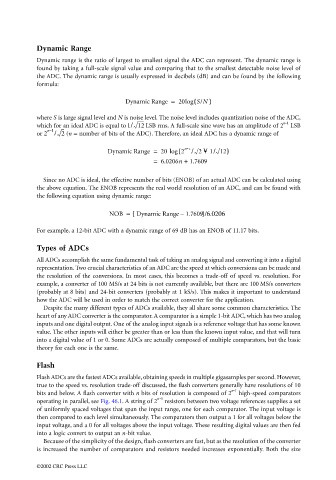Page 1188 - The Mechatronics Handbook
P. 1188
Dynamic Range
Dynamic range is the ratio of largest to smallest signal the ADC can represent. The dynamic range is
found by taking a full-scale signal value and comparing that to the smallest detectable noise level of
the ADC. The dynamic range is usually expressed in decibels (dB) and can be found by the following
formula:
Dynamic Range = 20log ( S/N )
where S is large signal level and N is noise level. The noise level includes quantization noise of the ADC,
n-1
which for an ideal ADC is equal to 1/ 12 LSB rms. A full-scale sine wave has an amplitude of 2 LSB
or 2 n-1 / 2 (n = number of bits of the ADC). Therefore, an ideal ADC has a dynamic range of
n-1
Dynamic Range = 20 log 2 ( / 2 ¥ 1/ 12)
= 6.0206n + 1.7609
Since no ADC is ideal, the effective number of bits (ENOB) of an actual ADC can be calculated using
the above equation. The ENOB represents the real world resolution of an ADC, and can be found with
the following equation using dynamic range:
NOB = ( Dynamic Range 1.7609 )/6.0206
–
For example, a 12-bit ADC with a dynamic range of 69 dB has an ENOB of 11.17 bits.
Types of ADCs
All ADCs accomplish the same fundamental task of taking an analog signal and converting it into a digital
representation. Two crucial characteristics of an ADC are the speed at which conversions can be made and
the resolution of the conversions. In most cases, this becomes a trade-off of speed vs. resolution. For
example, a converter of 100 MS/s at 24 bits is not currently available, but there are 100 MS/s converters
(probably at 8 bits) and 24-bit converters (probably at 1 kS/s). This makes it important to understand
how the ADC will be used in order to match the correct converter for the application.
Despite the many different types of ADCs available, they all share some common characteristics. The
heart of any ADC converter is the comparator. A comparator is a simple 1-bit ADC, which has two analog
inputs and one digital output. One of the analog input signals is a reference voltage that has some known
value. The other inputs will either be greater than or less than the known input value, and that will turn
into a digital value of 1 or 0. Some ADCs are actually composed of multiple comparators, but the basic
theory for each one is the same.
Flash
Flash ADCs are the fastest ADCs available, obtaining speeds in multiple gigasamples per second. However,
true to the speed vs. resolution trade-off discussed, the flash converters generally have resolutions of 10
n-1
bits and below. A flash converter with n bits of resolution is composed of 2 high-speed comparators
n-1
operating in parallel, see Fig. 46.1. A string of 2 resistors between two voltage references supplies a set
of uniformly spaced voltages that span the input range, one for each comparator. The input voltage is
then compared to each level simultaneously. The comparators then output a 1 for all voltages below the
input voltage, and a 0 for all voltages above the input voltage. These resulting digital values are then fed
into a logic convert to output an n-bit value.
Because of the simplicity of the design, flash converters are fast, but as the resolution of the converter
is increased the number of comparators and resistors needed increases exponentially. Both the size
©2002 CRC Press LLC

